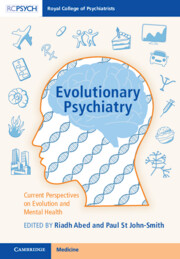Book contents
- Evolutionary Psychiatry
- Reviews
- Evolutionary Psychiatry
- Copyright page
- Contents
- Contributors
- Foreword
- Preface
- Chapter 1 Introduction to Evolutionary Psychiatry
- Chapter 2 The Biopsychosocial Model Advanced by Evolutionary Theory
- Chapter 3 Hominin Evolution I
- Chapter 4 Hominin Evolution II
- Chapter 5 Hunter-Gatherers, Mismatch and Mental Disorder
- Chapter 6 Why Do Mental Disorders Persist?
- Chapter 7 Anxiety Disorders in Evolutionary Perspective
- Chapter 8 Evolutionary Perspectives on Depression
- Chapter 9 On the Randomness of Suicide
- Chapter 10 Evolutionary Perspectives on Schizophrenia Spectrum Disorders
- Chapter 11 Evolutionary Perspectives on Eating Disorders
- Chapter 12 Substance Abuse and Evolution
- Chapter 13 The Social Function of Alcohol from an Evolutionary Perspective
- Chapter 14 Evolutionary Perspectives on Childhood Trauma
- Chapter 15 Evolutionary Perspectives on Neurodevelopmental Disorders
- Chapter 16 Maternal Negativity and Child Maltreatment
- Chapter 17 Alzheimer’s Disease as a Disease of Evolutionary Mismatch, with a Focus on Reproductive Life History
- Chapter 18 Psychopharmacology and Evolution
- Chapter 19 What the Evolutionary and Cognitive Sciences Offer the Sciences of Crime and Justice
- Chapter 20 Evolutionary Thinking and Clinical Care of Psychiatric Patients
- Index
- References
Chapter 10 - Evolutionary Perspectives on Schizophrenia Spectrum Disorders
Published online by Cambridge University Press: 08 September 2022
- Evolutionary Psychiatry
- Reviews
- Evolutionary Psychiatry
- Copyright page
- Contents
- Contributors
- Foreword
- Preface
- Chapter 1 Introduction to Evolutionary Psychiatry
- Chapter 2 The Biopsychosocial Model Advanced by Evolutionary Theory
- Chapter 3 Hominin Evolution I
- Chapter 4 Hominin Evolution II
- Chapter 5 Hunter-Gatherers, Mismatch and Mental Disorder
- Chapter 6 Why Do Mental Disorders Persist?
- Chapter 7 Anxiety Disorders in Evolutionary Perspective
- Chapter 8 Evolutionary Perspectives on Depression
- Chapter 9 On the Randomness of Suicide
- Chapter 10 Evolutionary Perspectives on Schizophrenia Spectrum Disorders
- Chapter 11 Evolutionary Perspectives on Eating Disorders
- Chapter 12 Substance Abuse and Evolution
- Chapter 13 The Social Function of Alcohol from an Evolutionary Perspective
- Chapter 14 Evolutionary Perspectives on Childhood Trauma
- Chapter 15 Evolutionary Perspectives on Neurodevelopmental Disorders
- Chapter 16 Maternal Negativity and Child Maltreatment
- Chapter 17 Alzheimer’s Disease as a Disease of Evolutionary Mismatch, with a Focus on Reproductive Life History
- Chapter 18 Psychopharmacology and Evolution
- Chapter 19 What the Evolutionary and Cognitive Sciences Offer the Sciences of Crime and Justice
- Chapter 20 Evolutionary Thinking and Clinical Care of Psychiatric Patients
- Index
- References
Summary
The term ‘schizophrenia’ refers to a group of disorders that seem to occur worldwide, with clinical pictures being strikingly similar across cultures. Evolutionary explanations of these disorders are warranted for at least two reasons: the first concerns their prevalence in all known ethnicities; the second relates to the need to explain the paradox as to why the conditions are maintained despite the greatly decreased fecundity of the affected individuals. Accordingly, a plethora of heterogeneous hypotheses – unparalleled among other psychiatric disorders – have been put forth, some of which deal with genetic considerations, others with environmental risk factors, and a few consider the adaptive advantages associated with the genes that predispose to schizophrenia. None of the evolutionary scenarios has the potential to account for the diversity of the symptomatology or to cover all of the biological and non-biological aspects of schizophrenia or schizophrenia spectrum disorders. This chapter aims at discussing the most relevant evolutionary hypotheses of schizophrenia, arguing that a symptom-based approach to psychotic disorders from an evolutionary perspective may improve upon the existing models of schizophrenia.
Keywords
- Type
- Chapter
- Information
- Evolutionary PsychiatryCurrent Perspectives on Evolution and Mental Health, pp. 153 - 168Publisher: Cambridge University PressPrint publication year: 2022



